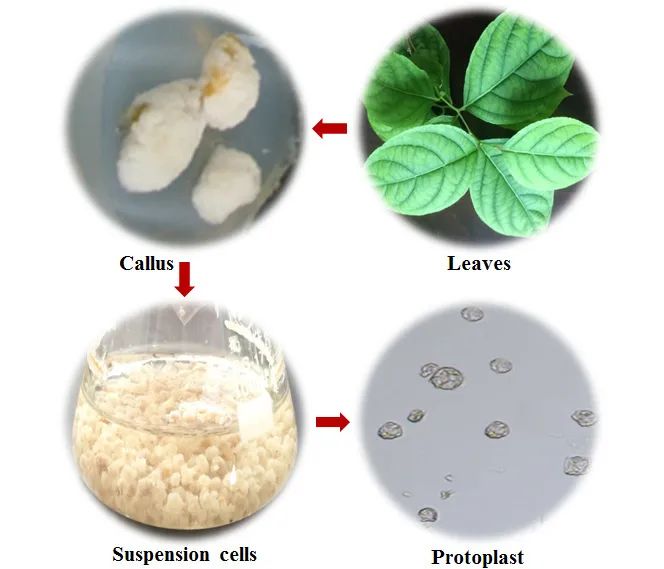Influencing Factors of Plant Cell Suspension Culture
News 8 4 月, 2025
Plant cell suspension culture is a common cell culture technique widely used for producing secondary metabolites, such as polysaccharides, saponins, alkaloids, flavonoids, and polyphenols.
What is Cell Suspension Culture?
Plant cell suspension culture refers to the cultivation of plant cells or small cell clusters in a liquid medium on a shaker. These cells or clusters originate from callus tissues, specific organs, tissues, or even tender plants, obtained through physical or chemical separation methods.

Compared to traditional whole-plant materials, plant cell suspension culture offers advantages due to its good dispersal, uniform cell shapes and sizes, rapid growth, reproducibility, and ease of control. It is widely used in studies of physiology, cell biology, biochemistry, developmental biology, genetics, and molecular biology.
Key Conditions for Plant Cell Suspension Culture:
For a successful cell suspension culture system, the following three basic conditions must be met:
- Good dispersal of cell cultures, with cell clusters typically consisting of a few dozen cells, rarely composed entirely of single cells.
- Good uniformity, with consistent cell shapes and sizes, appearing as uniformly sized small particles under an inverted microscope.
- Growth rate, with cell mass generally doubling in 2 to 3 days or even shorter.
Therefore, before large-scale production, it is necessary to disperse callused cells to the maximum extent and select from them fast-growing strains with high content of useful components.

To obtain single cells and small cell clusters from callus tissues, it is first necessary to obtain loose callus tissues. From the callus tissues of subcultures, select those that are loose in texture, pale yellow in color, and granular on the surface. Inoculate them into a triangular flask containing culture liquid (usually about one-third of the flask volume), crush them with tweezers into relatively uniform small particles, and place them on a shaker for suspension culture. After one week, filter through a 200-mesh stainless steel screen to remove large cell clusters and add fresh culture medium to start the subculture.
Factors Influencing Plant Cell Suspension Culture:
- Initial Inoculation Amount: The growth of suspension cells exhibits a clumping effect; too low a cell density slows growth, while too high a density accelerates growth but can lead to harmful substance accumulation, making it difficult to establish a suspension cell line. An appropriate density promotes cell growth, facilitates culture dispersal, and establishes embryogenic cell lines. During subculture, the initial inoculation amount should ideally be about 1.5g of culture in 40ml of liquid medium.
- Hormone Concentrations: Hormones significantly influence cell states. A culture medium without 2,4-D cannot establish a suspension cell line. Too low a concentration of 2,4-D impedes dispersion, while a high concentration promotes cell division but may lead to vacuolization, detrimental to somatic embryo development. The type and ratio of hormones greatly impact cell growth and secondary metabolite proliferation.
- Sucrose Concentration: Sucrose is an essential carbon source and osmotic regulator in tissue culture. For example, in strawberry suspension cultures, as the sucrose concentration increases to 30g/L, cell proliferation maximizes; beyond 60g/L, proliferation significantly decreases.
- Impact of Additives: Organic additives like hydrolyzed casein, yeast extract, coconut milk, and malt extract enhance the growth of plant tissues and cells in vitro. In attempts to establish grass family plant embryogenic cell suspension lines, these additives have been shown to promote growth, proliferation, and enhance embryogenic capabilities.
- Cell Suspension Culture and pH: The growth of suspension cultures has an optimal pH; for example, in rice suspension cell cultures, a pH of 6.0 results in faster growth and a 4.4-fold increase in fresh weight. However, the growth rate and pH of suspension cell lines can vary during culture.
- Subculture Period of Suspension Cell Lines: The growth curve of suspension cultures provides crucial data for determining the subculturing period, ensuring timely medium changes and stabilizing the suspension system.
Conclusion: Plant cell suspension culture technology has achieved significant successes, not only addressing major theoretical issues in higher plant cell biology but also being broadly applied in practical fields such as crop variety improvement and industrial production of secondary metabolites.